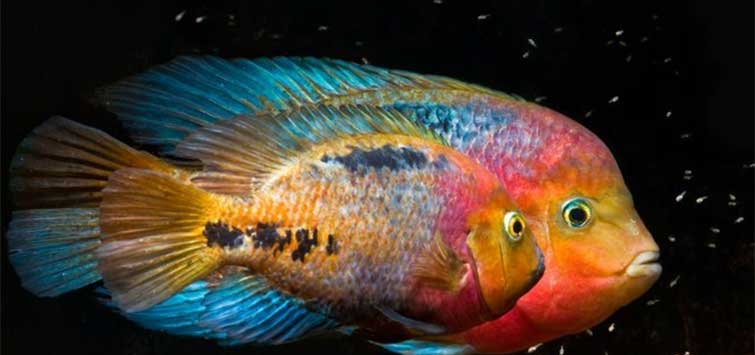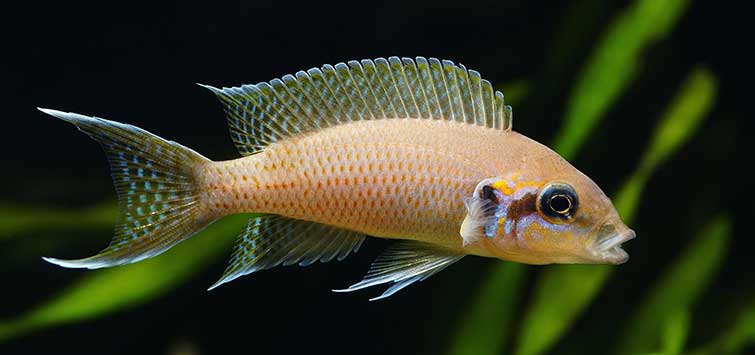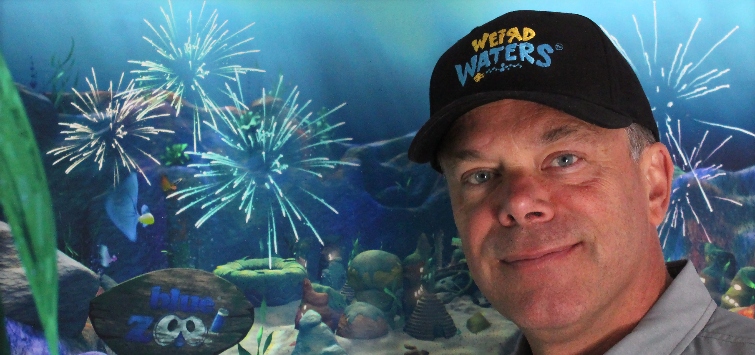Cichlid Camera Magic
Author: Mo Devlin
A noted cichlid photographer offers a selection of stunning photography and explains how exceptional scenes can be captured.
Picture-Perfect Cichlids
I am a cichlid voyeur who spends countless hours standing in front of their home, camera in hand, observing and documenting their behavior as they live, eat, and breed. The fascination never dims.
My love for cichlids started long before I was ever introduced to a camera. My passion for photography led me down a career path that started in the army as a photojournalist and later a medical photographer. Today I am the owner of a small advertising agency. My two passions, cichlids and photography, have dovetailed nicely and provided me great pleasure over the years.
I credit my technical skills to the fact that I cut my teeth using the old manual Pentax and the Nikkormat film cameras. Their functioning was very basic; nothing was automatic. And everything was final once the shutter was pressed. Never was that fact more important than when I photographed autopsies while in the army. My boss was always fond of reminding me I had to get it right the first time. “We don’t dig them up for a reshoot,” he would say. Those hard-learned technical lessons certainly paid dividends when I got my first digital SLR.
I started taking pictures of my fish seriously with my Nikon film camera. I had mixed results or, as I like to look back at them, expensive experiments. While I could get an image, it was never anything worth putting on a wall. I fared a little better with my first digital point-and-shoot.
The big ah-ha! moment came when I bought my first Nikon DSLR camera. The pictures improved from a technical standpoint, but they were still lacking from a photographer’s eye. Sure, I could get a nice image of a nice fish, but I wanted to create art—and that can fall into a couple different categories.
Cichlid Behavior
As most who keep cichlids are aware, they are very interactive fish, some more so than others. I have said many times that the fish is doing all the heavy lifting. I’m simply there to click the shutter. I know what to expect when my fish are breeding, but documenting behavior basically comes down to being in the right place at the right time.
The voyeur becomes the paparazzi. I shoot hundreds of pictures every week, and sometimes that much in a day. One of the things that most don’t know is that for every good photo I show, there are more than twenty that never get off the memory card.
I can’t prove it, but I could swear that some of my fish know they are being photographed. In particular, a pair of managuense that are arguably the most photographed individual pair of this species on the Internet. I take hundreds of photos of these fish in particular. They never fail to provide me with something that I can use.
Capturing Fluid Beauty
One of the most intriguing things about fish is their liquid-like grace in water. Their movement seems effortless and comparable to birds in flight.
It’s always a special treat when I can freeze that moment in time just before the fish flicks a fin and rockets into another part of the tank. Once again, it’s about being in the right place at the right time. On rare occasions, you can anticipate movement and get the shot. When that happens, it becomes stop-action magic.
I’ve tried everything from a laser pointer to the tips of my socked feet as tools to help get the desired results. After setting the lights on the tank, I step back and lure my subject into range. Then it’s a simple matter of waiting for the fish. Patience has never been one of my virtues, but in this case, the payoff is big.
Bits and Pieces
Is it the sum of all the parts, or can the parts themselves be the focus of a photo? Once, quite by accident, I got a photo of the tail end of a fish. It was another ah-ha! moment. A new avenue was opened, and I started taking pictures of smaller, more specific elements—they can indeed make a great picture. Some of my favorite photos now are simply close-ups of fins, eyes, fry, or scales.
Perfect Portraits
How many times do you see the underside of a fish properly lit in a photo? A few years ago, I started experimenting with a three-flash setup. I would place one of the flash units beneath the tank pointed up through a cleared space in the gravel. The effect gave a new dimension to the photos.
This technique led me to try and capture better portraits of my fish. The better shots are the side-by-side comparisons of male and female. One shot in particular, a pair of fish with heads tilted up, was taken in simple fashion. I set up the camera and lights, and then put my lens cap on the top of the tank. When they looked up, I took the photo.
The Big Payoff
For over a decade, I’ve posted my photos across the Internet on dozens of forums, both national and international under the heading, “Today in the Fishroom.” Occasionally, I will get a note from a fellow aquarist saying that they picked up a fish simply because they saw it in one of my photos. Many of these folks are being introduced into the world of cichlids for the first time. For me, that’s the ultimate compliment.
One of my good friends once jokingly said, “One thing is for sure. If you get a fish in your tank, his life is well documented.” Isn’t that the truth! I like to believe that this is my contribution back to a hobby that has given me so much joy over the years. I hope to see you all at this year’s American Cichlid Association convention in Washington, D.C. Bring your camera!
See the full article on TFH Digital http://www.tfhdigital.com/tfh/201107#pg61

.png?h=595&iar=0&w=2781&hash=5FD5E69473BCC22199FBFA2FB71B6033)




